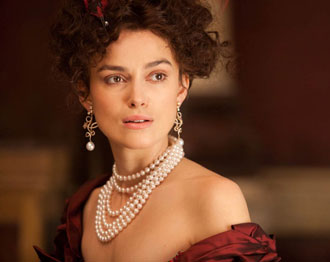 Focus Features
Focus Features
130 min., dir. by Joe Wright, with Keira Knightley, Jude Law, and Aaron Taylor-Johnson
Many adaptations of Tolstoy’s classic, Anna Karenina — be they on the screen, tube, or stage — have found their way to the watchful eyes of the public. Directed by Joe Wright and scripted by the masterful Tom Stoppard, this iteration does a wonderful job of portraying the story’s main themes while beefing up the importance of Levin’s story arc; however, it suffocates under its overly clever presentation.
Related Posts
At this point, everyone should be familiar with the tragic story of young Anna Karenina (played by Keira Knightley in her third film under Joe Wright), so let’s jump right into the highs and low of the film. Two weeks before principle photography was to begin, director Joe Wright decided to film the entire piece in a single location. Taking place in a large Victorian-style theater, set pieces drop in and out as the actors trounce from one side of the theater to the other as background actors flip their military uniforms inside out to play the waiters in the next scene as the action sweeps across every section of the theater.
The stage, the floor, the rafters, the underbelly — every inch of the enormous theater is used to portray another landscape of this vast world. It’s certainly ambitious, and most of it is thoroughly impressive in terms of the overall look presented. Yet for as breathtaking as the icy snows covering the ground and frosting the full-size steam train that barrels its way onto the theater floor may seem, the entire affair feels slightly cocky. While even though I don’t feel Joe Wright was intentionally under this mindset, I couldn’t help but feel each set change scream, “Well, look at what I can do!”
It’s a well-known fact that the character of Levin (played by Domhnall Gleeson) is in fact Tolstoy’s characterization of himself. The Levin/Princess Kitty story is just as important as Anna’s to the overall message. While always a part of the story, previous works have not weighed in the Levin story as heavily. The title may be Anna Karenina, but it’s not just about her. Even though Stoppard focuses on presenting larger scopes of the story, Levin disappears for larger chunks of time near the middle of the film, creating an uneven story structure. The tryst of Anna, Vronsky, and Karenin is certainly more tantalizing, but isn’t that the point? There’s a contrast that should be presented between what we lust for and what we live for. Even though Stoppard and Wright deliver the true love aspect of the story, they still fall short of giving it a sufficient attention.
Lovers of period dramas won’t be disappointed. The entire film may rarely leave its static location, but it doesn’t disappoint in delivering elaborately beautiful sets and colorfully lavish costumes. Every performance is on par from what one deserves from a well purposed drama, but all of that is shrouded under the overbearing shadow of the film’s showy staging.
—
Matthew Schuchman is the founder and film critic of Movie Reviews From Gene Shalit’s Moustache (http://shalitsstache.com) and the contributing film writer forIPaintMyMind(http://ipaintmymind.org).